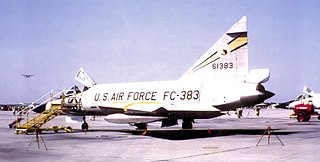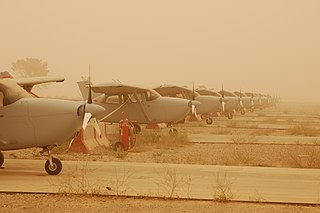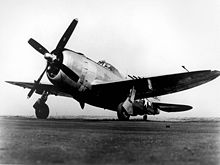
The 343d Wing is an inactive United States Air Force unit. Its last assignment was with Pacific Air Forces at Eielson Air Force Base, Alaska, where it was inactivated on 20 August 1993. The unit was formed at Eielson as the 343d Composite Wing and activated in October 1981 to replace the 5010th Combat Support Group. It operated both fighter and forward air control aircraft. In 1991, it also became the administrator for periodic Exercise Cope Thunder operations, which moved to Alaska from the Philippines after the eruption of Mount Pinatubo resulted in the evacuation of units from Clark Air Base When the wing was inactivated, it was replaced at Eielson by the 354th Fighter Wing.

The 328th Armament Systems Wing is an inactive wing of the United States Air Force (USAF). It was last active in 2007, assigned to the Air Armament Center, part of Air Force Materiel Command (AFMC) at Eglin Air Force Base, Florida. It was first activated in 1942 as the 328th Fighter Group and served during World War II as a fighter aircraft training unit until disbanded in 1944 in a major reorganization of the Army Air Forces.

The 326th Aeronautical Systems Wing is an inactive wing of the United States Air Force. It was last assigned to the Aeronautical Systems Center at Wright-Patterson Air Force Base, Ohio, where it was inactivated in 2008.

The 323d Fighter-Interceptor Squadron is an inactive United States Air Force unit. Its last assignment was with Air Defense Command at Ernest Harmon Air Force Base, Newfoundland, where it was inactivated on 1 July 1960.

The 498th Fighter-Interceptor Squadron is an inactive United States Air Force unit. Its last assignment was with Air Defense Command stationed at Hamilton Air Force Base, California. It was inactivated on 30 September 1968.

The 331st Fighter-Interceptor Squadron is an inactive United States Air Force unit. Its last assignment was with Air Defense Command at Webb Air Force Base, Texas, where it was inactivated on 1 March 1967.

The 327th Fighter-Interceptor Squadron is an inactive United States Air Force unit. Its last assignment was with the 64th Air Division at Thule Air Base, Greenland, where it was inactivated on 25 March 1960.

The 539th Fighter-Interceptor Squadron is an inactive United States Air Force unit. Its last assignment was with the 26th Air Division at McGuire Air Force Base, New Jersey, where it was inactivated on 31 August 1967.

The 98th Fighter-Interceptor Squadron is an inactive United States Air Force unit. Its last assignment was with the New York Air Defense Sector of Air Defense Command stationed at Suffolk County Air Force Base, New York, where it was inactivated on 30 September 1968.

The 325th Fighter-Interceptor Squadron is an inactive United States Air Force unit, last assigned to Air Defense Command at Truax Field, Wisconsin, where it was inactivated on 25 June 1966.

The 326th Fighter-Interceptor Squadron is an inactive United States Air Force unit. Its last assignment was with the 328th Fighter Wing at Richards-Gebaur Air Force Base, Missouri, where it was inactivated on 2 January 1967.

The 84th Combat Sustainment Group is an inactive United States Air Force (USAF) group last assigned to the 84th Combat Sustainment Wing at Hill Air Force Base, Utah, where it was inactivated in 2010. The group was formed in 1942 as the 84th Bombardment Group, one of the first dive bomber units in the United States Army Air Corps and tested the Vultee Vengeance, proving that aircraft unsuitable as a dive bomber. As an Operational Training Unit, it was the parent for several other bombardment groups, but from 1943 until it was disbanded in 1944, trained replacement aircrews as a Replacement Training Unit designated the 84th Fighter-Bomber Group.

The 438th Fighter-Interceptor Squadron is an inactive United States Air Force unit. Its last assignment was with the 35th Air Division at Griffiss Air Force Base, New York, where it was inactivated on 30 September 1968. The squadron was first activated as the 438th Fighter Squadron during World War II. It served as an Replacement Training Unit until the spring of 1944, when it was disbanded in a general reorganization of Army Air Forces training units. It was reactivated in 1953 as an air defense unit and served in that role until inactivated.

The 525th Air Defense Group is a disbanded United States Air Force organization. Its last assignment was with the 4710th Air Defense Wing at New Castle County Airport, Delaware, where it was inactivated on 18 August 1955. The group was originally activated as the 525th Air Service Group, a support unit for a combat group at the end of World War II in Italy and then redeployed to Maine, where it supported redeploying units until it was inactivated in 1945.

The Chicago Air Defense Sector (CADS) is an inactive United States Air Force organization. Its last assignment was with the Air Defense Command (ADC) 30th Air Division at Truax Field Wisconsin. It was inactivated on 1 April 1966.
The 4706th Air Defense Wing is a discontinued United States Air Force (USAF) organization. Its last assignment was with the 37th Air Division of Air Defense Command (ADC) at O'Hare International Airport (IAP), Illinois where it was discontinued in 1956. It was established in 1952 at O'Hare as the 4706th Defense Wing in a general reorganization of Air Defense Command (ADC), which replaced wings responsible for a base with wings responsible for a geographical area. It assumed control of several Fighter Interceptor squadrons that had been assigned to the 142d Fighter-Interceptor Wing, an Air National Guard wing mobilized for the Korean War and the 56th Fighter-Interceptor Group. In early 1953 it also was assigned six radar squadrons in the Midwest and its dispersed fighter squadrons combined with colocated air base squadrons into air defense groups. The wing was redesignated as an air defense wing in 1954. It was discontinued in 1956 and most of its units transferred to the 58th Air Division.

The 520th Air Defense Group is a disbanded United States Air Force organization. Its last assignment was with the 4706th Air Defense Wing at Truax Field, Wisconsin, where it was inactivated in 1955. The group was originally activated as the 520th Air Service Group, a support unit for the 340th Bombardment Group at the end of World War II in Italy and then redeployed to the United States where it was inactivated in 1945.

The 575th Air Defense Group is a disbanded United States Air Force organization. Its last assignment was with the 4708th Air Defense Wing at Selfridge Air Force Base, Michigan, where it was inactivated in August 1955. The group was originally activated as the 575th Air Service Group, a support unit for the 4th Fighter Group after the 4th returned to the United States at the end of World War II and performed that mission until it was inactivated in 1947.

The 564th Air Defense Group is a disbanded United States Air Force organization. Its last assignment was with the 4707th Air Defense Wing, at Otis Air Force Base, Massachusetts, where it was inactivated in 1955. The group was originally activated as the 564th Air Service Group, a support unit for a combat group at the end of World War II but never deployed before it was inactivated in 1945.

The 337th Aeronautical Systems Group is an inactive United States Air Force unit. Its last assignment was with the Aeronautical Systems Center of Air Force Materiel Command at Wright Patterson Air Force Base, Ohio, where it was inactivated in 2008.































